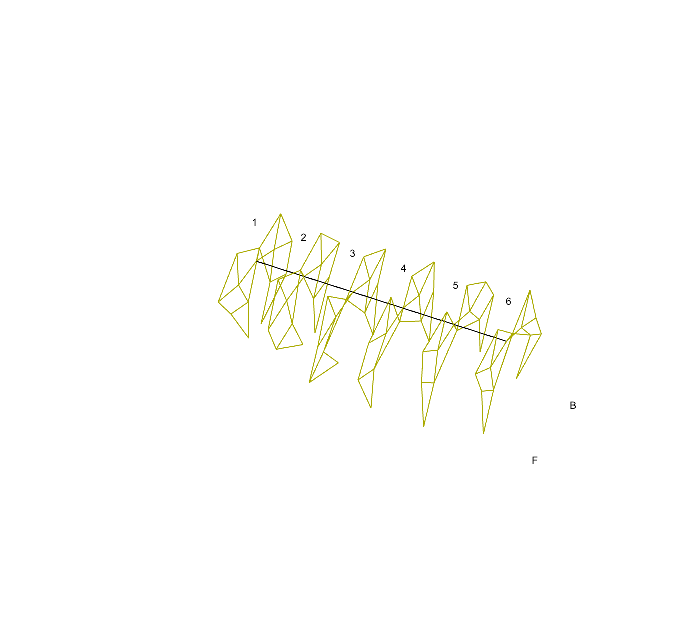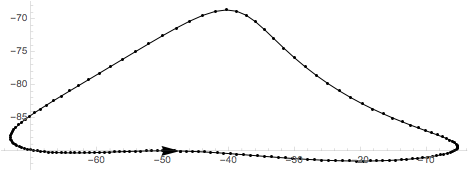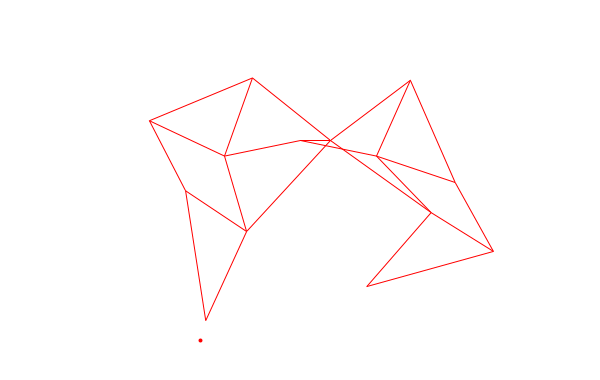For 6 pairs of legs (seen in many build-kits), with the phase difference of each successive pairs of legs just being Pi/3, you will get the following animation:

where I marked each pair by number and by F(front) and B(back).
The trajectory of one of the feet can be obtained like so:
pts = Subdivide[0, 2 Pi, 150];
trajectoriesdata = (FindPoints /@ pts)\[Transpose];
trajectoriesdata = trajectoriesdata[[-1]];
Graphics[{Arrow[trajectoriesdata], Point[trajectoriesdata]}, Axes -> True]

To get the angles when it touching we find the minima and maxima in X position:
ClearAll[XPosFeet,XPosFeet2]
XPosFeet[\[Theta]_?NumericQ]:=FindPoints[\[Theta]][[-1,1]]
XPosFeet2[\[Theta]_?NumericQ]:=FindPoints[\[Theta]][[7,1]]
min\[Theta]=\[Theta]/.Quiet@FindMaximum[XPosFeet[\[Theta]],{\[Theta],2,1,3}][[2]];
max\[Theta]=\[Theta]/.Quiet@FindMinimum[XPosFeet[\[Theta]],{\[Theta],4.5,3,6}][[2]];
{min\[Theta]2,max\[Theta]2}={\[Pi]/2+(\[Pi]/2-min\[Theta]),3\[Pi]/2+(3\[Pi]/2-max\[Theta])}
ClearAll[LeftOnGroundQ,RightOnGroundQ]
LeftOnGroundQ[\[Theta]_?NumericQ]:=!(min\[Theta]<Mod[\[Theta],2\[Pi]]<max\[Theta])
RightOnGroundQ[\[Theta]_?NumericQ]:=min\[Theta]2<Mod[\[Theta],2\[Pi]]<max\[Theta]2
Plot[XPosFeet[\[Theta]],{\[Theta],0,2\[Pi]},GridLines->{{min\[Theta],max\[Theta]},{}}]
Plot[XPosFeet2[\[Theta]],{\[Theta],0,2\[Pi]},GridLines->{{\[Pi]/2+(\[Pi]/2-min\[Theta]),3\[Pi]/2+(3\[Pi]/2-max\[Theta])},{}}]
Manipulate[Graphics[{Red,Line[FindLines[\[Theta]]],If[LeftOnGroundQ[\[Theta]],Disk[{-50,-100}],{}],If[RightOnGroundQ[\[Theta]],Disk[{50,-100}],{}]},PlotRange->{{-150,150},{-120,70}},ImageSize->800],{\[Theta],0,2\[Pi]}]
giving:

where the dot now indicates touching.
Now we can do some bigger code to generate a nice diagram:
mp=60;
n=6;
(*\[CurlyPhi]=Table[Mod[5\[Iota],n,1],{\[Iota],1,n}];*)
\[CurlyPhi]=Range[n];
Manipulate[
Graphics3D[{Darker@Yellow,Table[
{
Line[ Map[Prepend[mp \[Iota]],FindLines[\[Theta]+\[CurlyPhi][[\[Iota]]] (2Pi/n)],{2}]],
{Black,Text[\[Iota],{mp \[Iota],0,50}]}
},
{\[Iota],n}
]
,Black,Line[{{mp 1,0,0},{mp n,0,0}}]
,MapThread[Text[#1,{mp (n+1),#2,-100}]&,{{"F","B"},{-50,50}}]
}
,
Lighting->"Neutral",
PlotRangePadding->Scaled[.1],
PlotRange->{{-mp,(n+1)mp},{-150,150},{-150,150}},
Boxed->False,
ImageSize->700
]
,
{\[Theta],0,2\[Pi]}
]
separators={min\[Theta],max\[Theta],min\[Theta]2,max\[Theta]2};
separators=Table[separators-\[CurlyPhi][[\[Iota]]],{\[Iota],n}];
separators=Mod[Flatten[separators],2\[Pi]];
separators=separators//Prepend[0.0]//Append[2.0\[Pi]];
separators=Union[separators];
regions=Partition[separators,2,1];
expanded=Partition[Subdivide[0,2\[Pi],regions//Length],2,1];
ClearAll[MakeRegionPart]
MakeRegionPart[{\[Theta]start_,\[Theta]stop_},{start_,stop_}]:=Module[{eval,onground,ypos,xpos,pos,support},
eval=(\[Theta]start+\[Theta]stop)/2.0;
onground=Table[{LeftOnGroundQ[eval+\[CurlyPhi][[\[Iota]]]],RightOnGroundQ[eval+\[CurlyPhi][[\[Iota]]]]},{\[Iota],n}];
xpos=Subdivide[start,stop,3][[2;;-2]];
ypos=Subdivide[0.5,0,n+1][[2;;-2]];
pos=Partition[Reverse/@Tuples[{ypos,xpos}],2];
support=MapThread[If[#1,Disk[#2,0.02],{}]&,{onground,pos},2];
(*Print[support];*)
{
Line[{{{\[Theta]start,0.75},{\[Theta]start,1.25}},{{\[Theta]stop,0.75},{\[Theta]stop,1.25}}}],
Line[{{{start,0},{start,0.5}},{{stop,0},{stop,0.5}}}],
{Dashed,Opacity[0.5],Line[{{{\[Theta]start,0.75},{start,0.5}},{{\[Theta]stop,0.75},{stop,0.5}}}]},
support
}
]
xpos1=Subdivide[Sequence@@expanded[[1]],3][[2;;-2]];
ypos1=Subdivide[0.5,0,n+1][[2;;-2]];
Graphics[{
MapThread[MakeRegionPart,{regions,expanded}],
Text[#,{#,1.35}]&/@Range[0,2\[Pi],\[Pi]/2],
MapThread[Text[#1,{#2,-0.1}]&,{{"F","B"},xpos1}],
MapThread[Text[#1,{-0.1,#2}]&,{Range[n],ypos1}]
}
]
(*
plts=Table[
Plot[{If[LeftOnGroundQ[\[Theta]+\[CurlyPhi][[\[Iota]]]],20-4\[Iota],Missing[]],If[RightOnGroundQ[\[Theta]+\[CurlyPhi][[\[Iota]]]],20-(4\[Iota]+1),Missing[]]},{\[Theta],0,2\[Pi]}]
,
{\[Iota],n}
];
Show[plts,PlotRange\[Rule]All,GridLines\[Rule]{separators,{}},AspectRatio->1/5,ImageSize\[Rule]1000]*)
Giving:

I attached my notebook so you can change the number of feet and the relative phases between the legs...
Note that this notebook was not meant to be easily understood ;-)
 Attachments:
Attachments: